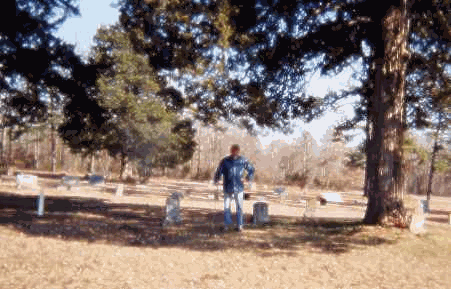
--photo by Leroy Blair
Glen Majors of Clay poses beside the grave of a slave at Howell Cemetery.
Clay was quite a town 90 years ago
By HEBER TAYLOR
Arkansas Democrat-Gazette, April 14, 2002
You wouldn’t expect a small village to have two private schools, both with a mix of boarding students and local scholars. But that was true of Clay in White County 90 or so years ago .
At that time, Clay was quite a little town. It had four stores, a post office, a cotton gin, a gristmill, a blacksmith shop and a livery stable or two. It was also said to have wooden sidewalks.
Three doctors were there to treat the sick. Clay also had a cemetery and at least two churches.
The two schools were the Clay Graded School, which was also known as the Clay High School, and the Clay Bible and Literary College. Both charged tuition. The graded school was started in 1907 and closed in 1910. Its main organizer and principal was James F. Boggs. Leister and Cloie Presley of Searcy and Glen Majors of Clay have materials that tell about Professor Boggs’ plans for the school. He promised thorough training in an ideal place for a school: "a village of good, quiet, sociable people (with) none of the vices or attractions of larger places." He said the school’s aim was to build character and give students the ability to think.
The school had nine grades and a teacher training class that prepared students to take the exam for a professor’s license, which was required of schoolteachers.
There were two three-month terms per year. Tuition ranged from $1.50 for the lower grades to $2.50 for the ninth grade. Glen Majors said that Professor Boggs’ salary was $50 a term. The school drew 93 students in 1907-08. Twenty-eight boarding students came from 10 area communities. Most stayed in homes of residents. Connie Yingling Patterson of Searcy said that her father, E.S. Yingling, had a place in his store where some boarding students could sleep. One who stayed in the store in 1908 was Luther G. Presley, who later became a well-known gospel songwriter. He taught music to pay for his tuition, his son Leister said.
The school was very strict. Dating was not allowed unless rules were suspended for a special event. Luther Presley met his future wife, Maggie Yingling, at the school. They married in 1911 after the school had closed. Leister Presley said his mother used to talk about the school’s rules. "She said the principal and directors slipped around at night to see whether the students were studying and behaving," he recalled.
When former students had a reunion in Searcy in 1967, Cloie Presley attended. She said that the alumni remembered Boggs as a very fine teacher. They also remembered that the school didn’t allow much communication between boys and girls. "But love will find a way," Cloie wrote in a report. "There were 13 marriages among students who attended the first two years. Most marriages began after the students were out of school."
Leon Van Patten of Searcy remembers hearing about a tragedy that involved the father of a 14-year-old boarding student. Vinson Henderson had just brought his daughter Eva back to Clary after she had visited her family in the Hiram community. While returning home, Vinson had to cross the rampaging Little Red River. Logs hit the ferry, knocking him off twice. He drowned at the age of 35.
The exact dates that the Clay Bible and Literary College opened and closed are not certain, but it’s thought that the two schools were operating at about the same time. J.H. "Dick" Adcock, who was later a pitcher in the St. Louis Cardinals’ farm system, attended the school as a youngster. He died several years ago, but in 1984, at age 85, he told the Little Red River Journal in Pangburn something about the school. He said that it was run by Mr. and Mrs. Oscar Dawson and that their three daughters and a son also taught there. "Believe me, it was taught by the tune of a hickory stick," Adcock said. "We had discipline back then. It was a strict school. If Mr. Dawson saw a girl and boy kissing, he would send them home."
Like Professor Boggs, the Dawsons also welcomed boarding students. Adcock remembered boys and girls coming from as far as St. Louis and Kansas City to attend. According to Adcock, the Dawsons’ school lasted three or four years. "It closed after getting deep in debt," he said, "and they moved to Heber Springs."
Today, only the Howell Cemetery, the Mount Pleasant Missionary Baptist Church, the ruins of one store and a few scattered homes are left to indicate that Clay was a prospering town a century ago. With two schools and all those local and boarding students, it must have been an exciting community.
People said that it was bigger than its neighbor Pangburn back then.